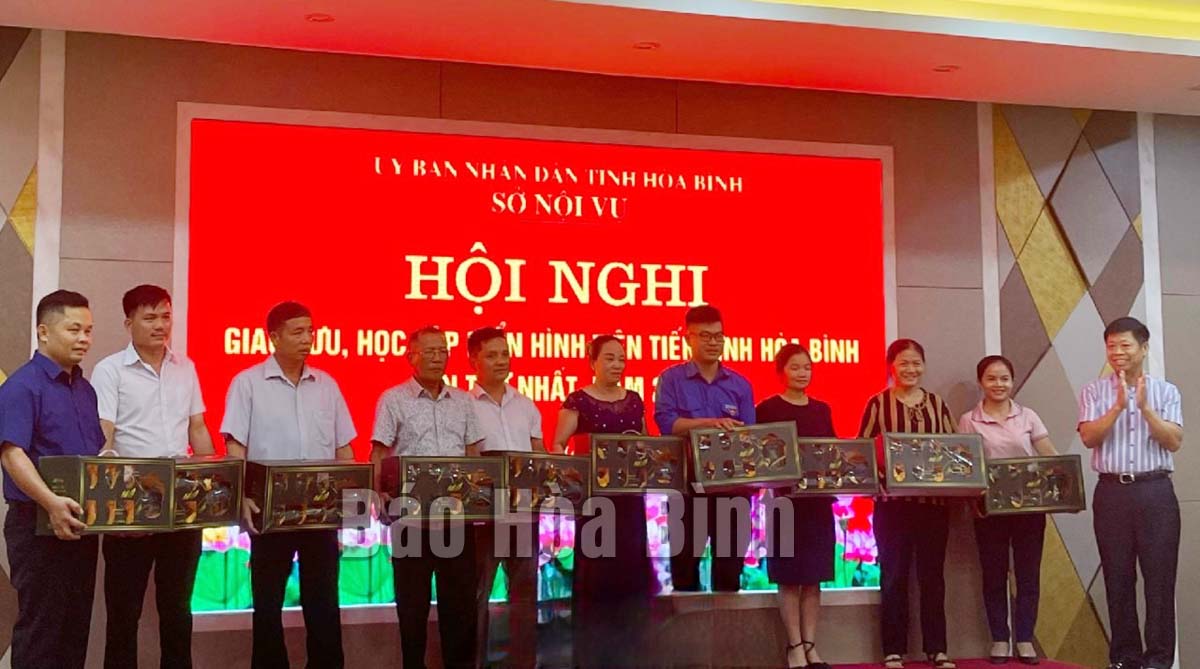
(HBO) – The Hoa Binh Provincial Council for Emulation and Commendation coordinated with the People’s Committee of Hoa Binh city to hold the first exchange conference for role models on July 7. The event was attended by leaders of the provincial Department of Home Affairs and the Hoa Binh Municipal People’s Committee, along with 41 individuals who are role models from localities across the province.

Photo: A leader of the provincial Department of Home Affairs
presents gifts to the exemplary individuals at the conference.
A leader of the Department of Home Affairs - the standing
body of the provincial Council for Emulation and Commendation - stressed that
patriotic emulation movements launched by central agencies and Hoa Binh
province have created strong changes to cadres, Party members and people’s
awareness and actions, encouraging them to make efforts to fulfill political
and socio-economic development tasks. Those campaigns have also provided
conditions for exemplary individuals to bring into play their role in promoting
emulation movements.
During 2016 - 2021 period, the province formed and
multiplied 125 exemplary models in different social aspects. Among them, 62
were introduced to central press agencies for popularisation.
At the conference, exemplary individuals shared their
experience in building effective livelihood models such as a cultivation model
applying VietGAP standards of Nguyen Trung Kien in Doc Lap commune and a plant
and livestock farming production model using high technology of Nguyen Thi Tam
in Tan Thinh ward (Hoa Binh city), a chicken farming model of Trinh Quang Tuan
in Phu Thanh commune (Lac Thuy district), a homestay tourism service model of
Sung Y Mua in Pa Co commune (Mai Chau district), an organic orange cultivation
model of 3T Farm Cooperative in Cao Phong town (Cao Phong district), and a
temperate vegetable production cooperative in Quyet Chien commune (Tan Lac
district).
On this occasion, the provincial Council for Emulation and
Commendation presented gifts to exemplary individuals and organised a
fact-finding trip to a guava farming model applying VietGAP standards in Yen
Mong commune of Hoa Binh city./.
According to data from the Hoa Binh Provincial Party Committee, the industrial production index for the first six months of 2025 is estimated to have increased by 20% compared to the same period last year. This marks the highest year-on-year growth rate for this period since 2020.
In the first six months of 2025, Hoa Binh province’s export turnover was estimated at 1.145 billion USD, marking an 18.11% increase compared to the same period in 2024. Import turnover was estimated at $ 804 million, a 17.15% increase, which helped the province maintain a positive trade balance.
The lives of the ethnic minority farmers in Tan Lac district have gradually improved thanks to the new directions in agricultural production. This is a testament to the collective strength fostered through the professional associations and groups implemented by various levels of the district’s Farmers’ Union.
With the motto the "product quality comes first,” after nearly one year of establishment and operation, Muong village’s Clean Food Agricultural and Commercial Cooperative, located in Cau Hamlet, Hung Son Commune (Kim Boi district), has launched reputable, high-quality agricultural products to the market that are well-received by consumers. The products such as Muong village’s pork sausage, salt-cured chicken, and salt-cured pork hocks have gradually carved out a place in the market and they are on the path to obtaining the OCOP certification.
In the past, the phrase "bumper harvest, rock-bottom prices" was a familiar refrain for Vietnamese farmers engaged in fragmented, small-scale agriculture. But today, a new spirit is emerging across rural areas of Hoa Binh province - one of collaboration, organisation, and collective economic models that provide a stable foundation for production.
Maintaining growing area codes and packing facility codes in accordance with regulations is a mandatory requirement for agricultural products to be eligible for export. Recently, the Department of Agriculture and Environment of Hoa Binh province has intensified technical supervision of designated farming areas and packing facilities to safeguard the "green passport" that enables its products to access international markets.



